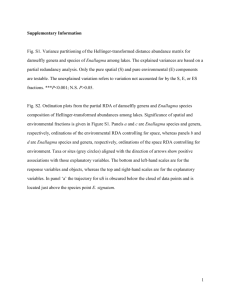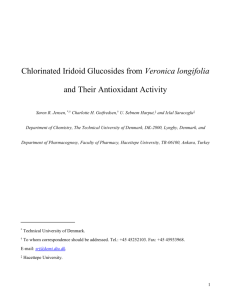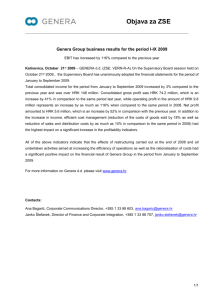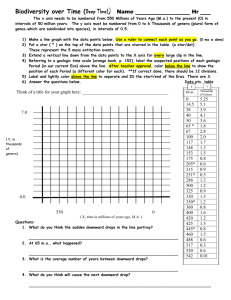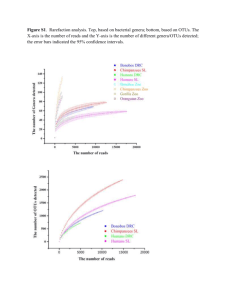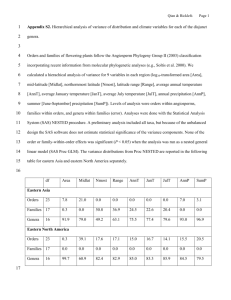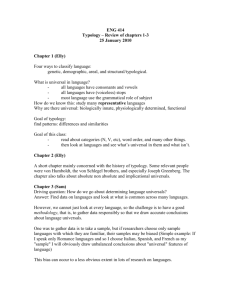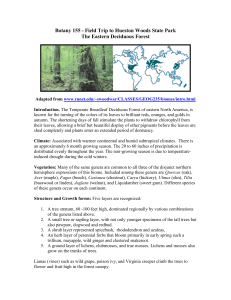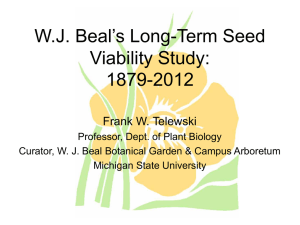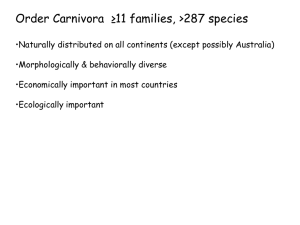Phytochemistry and molecular systematics of
advertisement
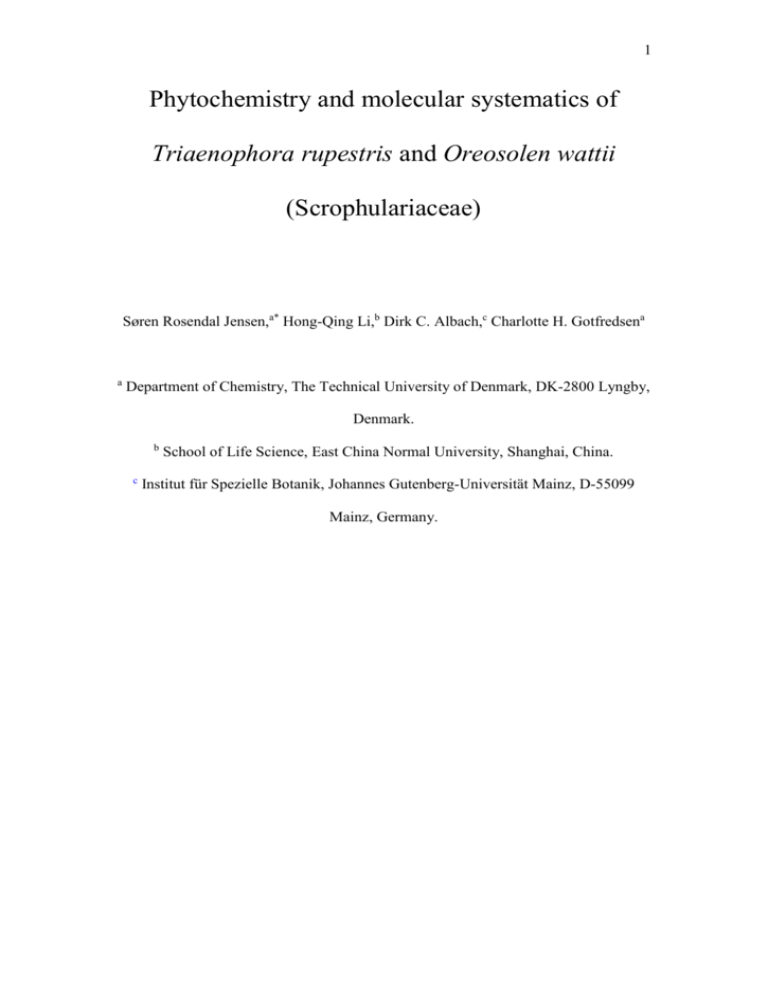
1 Phytochemistry and molecular systematics of Triaenophora rupestris and Oreosolen wattii (Scrophulariaceae) Søren Rosendal Jensen,a* Hong-Qing Li,b Dirk C. Albach,c Charlotte H. Gotfredsena a Department of Chemistry, The Technical University of Denmark, DK-2800 Lyngby, Denmark. b c School of Life Science, East China Normal University, Shanghai, China. Institut für Spezielle Botanik, Johannes Gutenberg-Universität Mainz, D-55099 Mainz, Germany. 2 Abstract The relationships between the genera Triaenophora, Oreosolen and Rehmannia were investigated. All three genera were previously included in tribe Veroniceae which was part of Scrophulariaceae but which is now included in Plantaginaceae. With regard to the content of iridoid glucosides, Triaenophora rupestris and the much-investigated Rehmannia were almost identical in containing catalpol, ajugol and 6-feruloylajugol. Oreosolen wattii was rather different in having compounds typical for the tribe Scrophularieae (Scrophulariaceae), namely aucubin, harpagide, harpagoside as well as two diesters of rhamnopyranosylcatalpol, one of which, here named oreosolenoside, had not previously been described in the literature. These results are consistent with recent analyses based on DNA sequencing and a phylogenetic tree illustrating the taxonomic relationships is presented. Keywords: Triaenophora, Oreosolen; Scrophulariaceae; Chemotaxonomy; Iridoid glucosides; Scorodioside; Oreosolenoside; Phylogeny. 3 1. Introduction Rehmannia Libosch. ex Fisch. et Mey. is a small genus of six species (Hong et al., 1998). Five of the six species are endemic to China with R. glutinosa (Gaert.) Libosch. ex Fisch. et Mey. extending further to Korea and Japan. Since the latter is important in traditional Chinese medicine, much chemical work has been performed on this species, and we have recently (Albach et al., 2007) extended this with an investigation of the remaining five species. Two other Chinese genera, namely Triaenophora and Oreosolen have traditionally been regarded as more or less related to Rehmannia and placed in Digitalideae (Bentham, 1846; Wettstein, 1891; Solereder, 1909; Li, 1948; Hong et al., 1998). Together with Titanotrichum, Triaenophora was segregated from within Rehmannia by Solereder (1909), but while the latter two were retained in the Digitalideae, the former was transferred to Gesneriaceae, a relationship later supported by DNA-sequence based analyses (Smith et al., 1997; Albach et al., 2001) Also the chemistry of Titanotrichum is consistent with this since T. oldhamii (Hemsl.) Soler. is devoid of iridoid glucosides (Jensen, 1996), a characteristic of Gesneriaceae which distinguishes it from most other Lamiales. Oreosolen, which was considered to be related to Ourisia and Lafuentea (Wettstein 1891) or to genera of Veroniceae (Hallier 1903), was recently moved to a much-reduced Scrophulariaceae by Oxelman et al. (2005). Using DNA sequencing, a sister-group relationship between Scrophularia and Oreosolen was discovered, and these genera also share a similar floral morphology and leaf architecture. Furthermore, the two genera are sisters to Verbascum, together comprising a clade that is predominantly north temperate in distribution, unlike most other lineages in Scrophulariaceae. 4 Triaenophora and Oreosolen are two small genera with only ca. 2 and 1 species respectively (Hong et al., 1998). Triaenophora rupestris (Hemsl.) Soler. is on the "red list" of endangered species in China, and is occasionally found on cliff faces in Hubei and Sichuan, China. Oreosolen wattii Hook.f. which is distributed in the Himalayas and Qinghai-Xizang Plateau, is used as a traditional Tibetan medicine for the treatment of fractures, open wounds and sprains. Chemical work on these two genera is very limited. Apparently, Triaenophora has not been investigated previously, and only a single work on Oreosolen wattii has been published (Yu et al., 1996) reporting the presence of verbascoside (7) together with four triterpenoid saponins, namely mimengosides A and B and buddlejasaponins I and Ia. 2. Results and discussion Dry material of Triaenophora rupestris from two different localities was investigated, and these were more or less identical in chemical content. Thus, the sugar fraction consisted mainly by sucrose and glucose with a little mannitol present, while the main iridoid constituents were catalpol (5), and ajugol (2) accompanied by verbascoside (7). Minor constituents were epiloganic acid (1) and two iridoid esters 6-feruloyl ajugol and 6-(p-coumaroyl) ajugol (2a and 2b). Such a profile of compounds is almost the same as that found in Rehmannia species (Albach et al., 2007) and the two ajugol esters 2a and 2b have so far only been reported from Rehmannia glutinosa (Nishimura et al., 1989). Thus, in chemical content, Triaenophora cannot be distinguished from Rehmannia, which agrees with the close relationship based on DNA sequence data (Fig. 1). 5 The result from Oreosolen wattii was quite different. The sugar fraction from this plant contained apparently only sucrose and glucose, while the main iridoids were aucubin (4), harpagide (3) as well as the 6-O-rhamnopyranosylcatalpol esters scorodioside (6a) and oreosolenoside (6b), of which the latter was new. Minor constituents were catalpol (5), methylcatalpol (5a) and harpagoside (3a). Oreosolenoside (6b) was obtained as a mixture of E/Z isomers and consequently, the specific rotation was not measured. The elemental formula was established to be C32H40O17 by HR-ESIMS. The NMR spectra (Table 1) were assigned using 1D and 2D techniques. The preparation was clearly a mixture of E/Z isomers, as seen by the two sets of 1H resonances at 6.42 (d, 16.0) and 5.88 (d, 12.8). The 13C NMR spectrum showed that all the signals arising from the aromatic part were doubled, while the remaining signals were not. This part of the spectrum was very similar to that of scorodioside (6a) from Scrophularia scorodonia L. (Fernandez et al., 1995), which is a 3''-acetyl-2''-cinnamoyl diester of 6--O-rhamnopyranosylcatalpol (see Table 1), except for the signals arising from the aromatic part. From the spectrum, however, it was obvious that this part of 6b was a p-coumaroyl moiety, and therefore the compound was an isomer of the two known diesters: scrophuloside A2 (a 2''acetyl-4''-p-coumaroyl diester) and scrophuloside A3 (a 3''-acetyl-4''-p-coumaroyl diester) found in Scrophularia nodosa L. (Miyase and Mimatsu, 1999). The 1H NMR spectrum was consistent with the presence of a 2'',3''-diester of 6--Orhamnopyranosylcatalpol, since the 2''- and the 3''-protons were observed at 5.4 and 5.2, respectively, which is 1.2 and 0.8 ppm, downfield from that of the unesterified iridoid (Taskova et al., 2006). Besides these signals, all the aromatic, the 6''-Me and the 6- and 7-proton were doubled. The positions of the acetyl groups of the E/Z-forms 6 were determined by the HMBC spectrum. In this, correlations between the 2''-protons at 5.39 and 5.35 and the aromatic carbonyl signals at 168.1 and 167.0 from the E- and the Z-forms, respectively, could be seen. Likewise, we found correlations between the 3''-protons at 5.16 and the aliphatic carbonyl signal at 172.3. This established the structure of the isolate to be 6-O-(3''-acetyl-2''-p-(E/Z)-coumaroylrhamnopyranosyl)-catalpol, and we have named the compound oreosolenoside. Regarding the presence of E- and Z-mixtures of p-coumaroyl esters in our isolates, we are uncertain whether one or the other exists in a pure form in the plants. We know however, that these forms easily isomerise either by gentle heating or by the influence of daylight since in one case we obtained the pure ester 2b from T. rupestris, and this had isomerised completely to the 1:1 mixture by standing for a month on the laboratory bench. Together with the four triterpenoid saponins previously reported from O. wattii (Yu et al., 1996), the iridoid composition found in the present work is consistent with a taxonomic position in Scrophulariaceae close to Scrophularia and Verbascum. Thus, the triterpenes found have also been reported from several species of both these genera as well as from some species of Buddleja (Tschesche et al., 1986; Klimek et al., 1992; Calis et al., 1993; Yamamoto et al., 1991; 1993; Hartleb and Seifert, 1996; Emam et al., 1996, 1997; Giner et al., 1998; 2000; Tatli et al., 2004; Arrif et al., 2006). With regard to the iridoids, most of those found in O. wattii, namely harpagide (3), harpagoside (3a), aucubin (4), catalpol (5), methylcatalpol (5a) and scorodioside (6a) have also been found in S. scorodonia and several other species (De Santos Galindez et al., 2001). With little variation, almost the same iridoid profile has been reported from V. thapsus L. (Warashina et al., 1991) and other species of that genus. 7 Thus, Oreosolen is chemically very similar to Scrophularia and Verbascum as it is also indicated by a phylogenetic analysis based on combined DNA sequence data from Albach et al. (2005), Oxelman et al. (2005) and Li et al. (in prep.) (see Fig. 1). In conclusion, 1) Triaenophora and Oreosolen are not related to Veroniceae and 2) the chemical results for both species investigated in this work are remarkably congruent with the phylogenetic results. 8 3. Experimental 3.1 General 1 H and 13C NMR spectra were recorded on a Varian Unity Inova-500 MHz in CD3OD using the solvent peak as the internal standard. Dry plant material was extracted by blending in EtOH. The mixture was brought to the boiling point and then left to stand at room temperature for some days. After filtering, the extract was taken to dryness and partitioned in H2O-Et2O (25 ml each); the aqueous layer was concentrated to give the crude extract, which was chromatographed using a Merck Lobar RP-18 column size B. The initial eluent was H2O followed by H2O:MeOH mixtures (15:1 to 4:5) and finally by MeOH. The content of sugars in the polar fraction was estimated by the intensity of the signals in 13C NMR spectrum. LC-HR ESIMS was performed on an Agilent HP 1100 Liquid Chromatograph equipped with a BDS-C18 reversed phase column running a water-acetonitrile (50 ppm TFA in water) gradient. The LC was coupled to a LCT of a TOF MS (Micromass, Manchester, UK) operated in the positive electrospray ion mode using 5-leucineenkephalin as lock mass. The isolated compounds were identified by their 1H and 13C NMR spectra by comparison with spectra of known standards: 1, 2, 4, 5, 5a and 7 (Taskova et al., 2006); ajugol esters 2a and 2b (Nishimura et al., 1989); 3 and 3a (Chaudhuri et al., 1980); scorodioside (6a) (Fernandez et al., 1995). 3.2 Plant material Material of Triaenophora rupestris was collected by HL in Jianshi, Hubei, China in July 2006 (voucher: Hongqing LI 2006998) and in Xingshan, Hubei, China in September 2007 (voucher: Hongqing LI 2007901). Oreosolen wattii was collected by 9 Yu-Hu Wu in Zaduo County, Qinghai, China in Aug. 2005 (voucher: Wuyuhu-001). Vouchers are deposited in Herbarium of East China Normal University (HSNU). 3.3.1 Triaenophora rupestris Dry leaf material from Jianshi (55 g) in EtOH (250 ml) for 7 days gave the crude extract (4.73 g) which upon chromatography gave the sugar fraction (1.2 g; mainly sucrose and glucose with ca. 20 % of mannitol), followed by catalpol (3; 1.43 g), ajugol (2; 260 mg), a fraction with mainly descaffeoylverbascoside (30 mg), epiloganic acid (1; 45 mg), verbascoside (7; 550 mg), isoacteoside (130 mg) and a fraction with mainly 6-feruloyl ajugol (2a; 80 mg). Rechromatography of the latter gave pure 2a. 3.3.2 Triaenophora rupestris Dry leaves and stem material from Xingshan (26 g) in EtOH (150 ml) for 10 days gave the crude extract (0.6 g) which upon chromatography gave the sugar fraction (190 mg), followed by catalpol (3; 200 mg), ajugol (2; 50 mg), verbascoside (7; 40 mg), and a fraction with a mixture of 6-feruloyl ajugol and 6-(p-coumaroyl) ajugol (2a and 2b; 15 mg). Rechromatography of the latter gave pure 2b. 3.4.1 Oreosolen wattii Dry leaves and stems (36 g) in EtOH (250 ml) for 11 days gave the crude extract (2.0 g) which was chromatographed to give the sugar fraction (410 mg; mainly sucrose and glucose), followed by catalpol (5; 80 mg), a 3:2:1 mixture of 3,4-dihydroaucubin, aucubin and 6-hydroxyantirrhinoside (40 mg), pure aucubin (4; 320 mg), harpagide (3; 180 mg), methylcatalpol (5a; 10 mg), a fraction with mainly verbascoside (7; 10 10 mg), a fraction (80 mg) with acylated rhamnopyranosylcatalpol mixture (including some 6b) which was not further separated and finally harpagoside (3a, 20 mg). 3.4.2 Oreosolen wattii Dry fruits (18 g) in EtOH (100 ml) for 10 days gave the crude extract (1.8 g) which was chromatographed to give the sugar fraction (370 mg; mainly sucrose and glucose), followed by catalpol (5; 10 mg), 3,4-dihydroaucubin (8 mg), aucubin (4; 110 mg), harpagide (3; 30 mg), methylcatalpol (5a; 70 mg), a fraction A (150 mg) and scorodioside (6a, 6-O-(3-acetyl-2-cinnamoyl-rhamnopyranosyl)-catalpol; 50 mg) A part (90 mg) of fraction A was rechromatographed to give oreosolenoside (6-O-(3''acetyl-2''-p-(E/Z)-coumaroyl-rhamnopyranosyl)-catalpol; 6b; 50 mg). 3.5 Oreosolenoside (6b) Amorphous solid: LC-HR ESIMS m/z: 714.2636 [M+NH4]+; (C32H44NO17 requires 714.2609); 1H and 13C NMR data in Table 1. Acknowledgements We thank Yu-Hu Wu (Institute of Tibetan Plateau Research, Chinese Acadmy of Sciences) for providing samples, and Kristian Fog Nielsen (BioCentrum, The Technical University of Denmark) for recording the mass spectrum. The study was supported by National Science Foundation of China (Project no.30770136 to HongQing Li). 11 References Albach, D. C., Soltis, P. S., Soltis, D. E., Olmstead, R. G., 2001. Phylogenetic analysis of asterids based on sequences of four genes. Ann. Missouri Bot. Gard. 88, 163-210. Albach, D. C., Li, H.Q., Zhao, N., Jensen, S. R., 2007. Molecular systematics and phytochemistry of Rehmannia (Scrophulariaceae). Biochem. Syst. Ecol. 35, 293300. Arrif, S., Benkhaled, M., Long, C., Lavaud, C., David, B., 2006. Glycosylated iridoids and a triterpene saponin from Verbascum ballii (Batt.) M. Qaiser. Biochem. Syst. Ecol. 34, 259-262. Calis, I., Zor, M., Basaran, A. A., Wright, A. D., Sticher, O., 1993. Ilwensisaponins A, B, C, and D: triterpene saponins from Scrophularia ilwensis. Helv. Chim. Acta 76, 1352-1360. Bentham, G., 1846. Scrophulariaceae. In: de Candolle, A. P. (Ed.), Prodromus Systematis Naturalis Regni Vegetabilis, vol. 10. V. Masson, Paris, pp. 180–586. Chaudhuri, R. K., Afifi-Yazar, F. U., Sticher, O., Winkler, T., 1980. Carbon13 NMR spectroscopy of naturally occurring iridoid glucosides and their acylated derivatives. Tetrahedron 36, 2317-2326. De Santos Galindez, J., Fernandez Matellano, L., Diaz Lanza, A. M., 2001. Iridoids from Scrophularia genus. Z. Naturforsch. 56c, 513-520. Emam, A. M., Moussa, A. M., Faure, R., Favel, A., Delmas, F., Elias, R., Balansard, G., 1996. Isolation and biological study of a triterpenoid saponin, mimengoside A, from the leaves of Buddleja madagascariensis. Planta Med. 62, 9293. 12 Emam, A. M., Diaz-Lanza, A. M., Matellano-Fernandez, L., Faure, R., Moussa, A. M., Balansard, G., 1997. Biological activities of buddlejasaponin isolated from Buddleja madagascariensis and Scrophularia scorodonia. Pharmazie 52, 76-77 Fernandez, L., Diaz, A. M., Ollivier, E., Faure, R., Balansard, G., 1995. An iridoid diglycoside isolated from Scrophularia scorodonia. Phytochemistry 40, 15691571. Giner, R. M., Villalba, M, L., Del Carmen Recio, M., Mainez, S., Gray, A. I., Rios, J. L., 1998. A new iridoid from Scrophularia auriculata ssp. pseudoauriculata. J. Nat. Prod. 61, 1162-1163. Giner, R. M., Villalba, M. L., Recio, M. C., Manez, S., Cerda-Nicolas, M., Rios, J., 2000. Anti-inflammatory glycoterpenoids from Scrophularia auriculata. Europ. J. Pharm. 389, 243-252. Hallier, E., 1903. Über Abgrenzung und Verwandtschaft der Sippen der Scrophulariaceen. Bull. Herb. Boiss. 3, 181-207. Hartleb, I., Seifert, K., 1995. Triterpenoid saponins from Verbascum songaricum. Phytochemistry 38, 221-224. Hong, D.Y., Yang, H., Jin, C.L., Holmgren, N.H., 1998. Scrophulariaceae. In: Wu Z.Y., Raven, P.H. (Eds), Flora of China. Science Press: Beijing, pp. 1-212. Jensen, S.R., 1996. Phenylethanoid glycosides in Sanango racemosa and in the family Gesneriaceae. Phytochemistry 43, 777-783. Klimek, B., Lavaud, C., Massiot, G., 1992. Saponins from Verbascum nigrum. Phytochemistry 31, 4368-4370. Li, H. L., 1948. A revision of the genus Rehmannia. Taiwania 1, 71-82, Plates I-V. 13 Miyase, T., Mimatsu, A., 1999. Acylated iridoid and phenylethanoid glycosides from the aerial parts of Scrophularia nodosa. J. Nat. Prod. 62, 1079-1084. Nishimura, H., Sasaki, H., Morota, T., Chin, M., Mitsuhashi, H., 1989. Chemical and biological studies on Rehmanniae radix. Part 3. Six iridoid glycosides from Rehmannia glutinosa. Phytochemistry 28, 2705-2709. Oxelman, B., Kornhall, P., Olmstead, R. G., Bremer, B., 2005. Further disintegration of Scrophulariaceae. Taxon 54, 411-425. Smith, J. F., Brown, K. D., Carroll, C. L., Denton, D. S., 1997. Familial Placement of Cyrtandromoea, Titanotrichum and Sanango, three problematic genera of the Lamiales. Taxon 46, 65-74. Solereder, H., 1909. Über die Gattung Rehmannia. Ber. Deutsch. Bot. Ges. 27, 390-404. Taskova, R. M., Gotfredsen, C. H,. Jensen, S. R., 2006. Chemotaxonomy of Veroniceae and its allies in the Plantaginaceae. Phytochemistry 67, 286-301. Tatli, I. I., Akdemir, Z. S., Bedir, E., Khan, I. A., 2004. Saponin, iridoid, phenylethanoid and monoterpene glycosides from Verbascum pterocalycinum var. mutense. Turk. J. Chem. 28., 111-122. Tschesche, R., Sepulveda, S., Braun, T. M., 1980. Triterpenes. XXXIII. Saponin of Verbascum phlomoides blossoms. Chem. Ber. 113, 1754-1760. von Wettstein, R., 1891. Scrophulariaceae. In: Engler, A., Prantl, K. (Eds.), Die natürlichen Pflanzenfamilien, IV, 3b. Engelmann, Leipzig, pp. 39-107. Warashina, T., Miyase, T., Ueno, A., 1991. Iridoid glycosides from Verbascum thapsus L. Chem. Pharm. Bull. 39, 3261-3264. 14 Yamamoto, A., Miyase, T., Ueno, A., Maeda, T., 1991. Buddlejasaponins IIV, four new oleanane-triterpene saponins from the aerial parts of Buddleja japonica Hemsl. Chem. Pharm. Bull. 39, 2764-2766. Yamamoto, A., Miyase, T., Ueno, A., Maeda, T., 1993. Scrophulasaponins IIIV, new saikosaponin homologs from Scrophularia kakudensis Franch. Chem. Pharm. Bull. 41, 1780-1783. Yu, G., Li, X., Wang, Y., Liu, Y., Yang, C., 1996. Spermicidal saponins from Oreosolen wattii. Yunnan Zhiwu Yanjiu 18, 229-233. 15 COOH HO RO O O HO OGlc OGlc 1; Epiloganic acid HO 2; R=H; Ajugol 2a; R=Feruloyl 2b; R=p-Coumaroyl HO OH O O RO HO OGlc 3; R=H; Harpagide 3a; R=Bz; Harpagoside 4; Aucubin RO 7 O 8 HO 10 O 4 6 3 5 9 O 1 Me HO AcO 6 O O O RhaO 1" O O OR HO OGlc 5; R=H; Catalpol 5a; R=Me; Methylcatalpol HO OGlc OGlc 6a; R=E-Cinnamoyl 6b; R=E/Z-Coumaroyl OH O O OH OH HO OH 7; Verbascoside 16 Table 1. NMR data (CD3OD) for oreosolenoside (6b) and the model scorodioside 6a. Atom Isomer Agluc 1 3 4 5 6 9 10 Glc 1' 2' 3' 4' 5' 6' Rha 1'' 2'' 3'' 4'' 5'' 6" Aroyl 1''' 2'''/6''' 3'''/5''' 4''' CO Acetyl CO Me Oreosolenoside ( 6b) 1H E Z 5.12 (obsc.) 6.41 (obsc.) 5.10 (obsc.) 2.51 (m) 4.09 (br. d, 8.7) 4.07 (br. d, 8.9) 3.70 (br. s) 3.69 (br. s) 2.61 (t-like, 8.5) 4.18 (d, 13.1) 3.84 (d, 13.1) 4.81 (d, 7.9) 3.27 (obsc.) 3.44 (t, 9.0) 3.30 (obsc.) 3.30 (obsc.) 3.95 (br. d, 11.7) 3.65 (obsc.) 5.08 (br. s) 5.39 (br. s) 5.15 (obsc.) 3.65 (obsc.) 3.89 (obsc.) 1.38 (d, 6.1) 5.04 (br. s) 5.35 (br. s) 1.32 (d, 6.2) 7.71 (2H; d, 8.5) 7.52 (2H; d, 8.5) 6.86 (2H; d, 8.5) 6.80 (2H; d, 8.5) 7.70 (d, 16.0) 6.42 (d, 16.0) 2.05 6.98 (d, 12.8) 5.88 (d, 12.8) 2.03 Scorodioside (6a) 1H E 13C E Z 13C E 95.1 142.3 103.3 37.1 84.3 59.4 66.5 43.2 61.4 5.10 (d, 9.5) 6.39 (dd, 6.0; 1.6) 5.11 (dd, 6; 4) 2.48 (m) 4.05 (br. d, 8) 3.67 (br. s) 99.6 74.7 77.6 71.6 78.5 62.8 4.78 (d, 7.9) 3.26 (obsc.) 3.40 (t, 8.9) 3.26 (obsc.) 3.27 (obsc.) 3.91 (dd, 12.3; 1.6) 99.7 74.8 77.6 71.8 78.6 62.9 97.7 71.2 73.1 71.6 70.2 18.0 5.07 (br. s) 5.37 (dd, 3; 1.5) 5.15 (dd,10.1; 3) 3.63 (obsc.) 3.87 (obsc.) 1.35 (d, 6.2) 97.7 71.1 73.2 71.3 70.2 17.9 7.64 (m, 2H) 7.43 (m, 3H) 7.43 (m, H) 7.75 (d, 16.0) 6.60 (d, 16.0) 135.5 129.4 130.1 131.8 147.3 118.1 167.5 127.0 131.4 116.9 161.4 147.6 114.3 168.1 172.3 20.9 2.58 (dd, 9.5; 7.8) 4.15 (d, 13.2) 3.81 (d, 13.2) 127.5 133.8 115.9 161.1 147.3 115.7 167.0 2.02 95.1 142.4 103.3 37.2 84.3 59.3 66.5 43.2 61.4 172.2 20.9 17 Figure 1. Phylogenetic relationships among former Scrophulariaceae and Lamiales based on DNA sequences from the ITS region, the trnL-trnL-trnF-regions and the rps16 intron. Data from Albach et al. (2005), Oxelman et al. (2005) and unpublished results.
